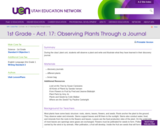
During the class' plant unit, students will observe a plant and write and illustrate what they have learned in their discovery journal.
- Subject:
- Education
- Elementary Education
- Material Type:
- Lesson
- Date Added:
- 05/15/2021

During the class' plant unit, students will observe a plant and write and illustrate what they have learned in their discovery journal.
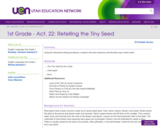
Using the interactive writing procedures, students will write sentences and illustrate ways seeds travel.
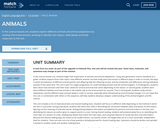
In this science-based unit, students begin their exploration of animals and animal adaptations. Using next generation science standards as a guide, students explore three main topics: how different animals use their body parts and senses in different ways in order to survive, the ways in which the behavior of different animal parents and offspring help the offspring survive, and the similarities and differences among individual animals of the same kind. This unit is part of a larger progression on understanding animals and the animal kingdom. In kindergarten, students learn about how animals meet their basic needs for survival and how that varies depending on the season. In second grade, students learn about different habitats and how animals in the habitat rely on the environment for survival. Then in third grade, students study animal adaptations and the different ways animals adapt in order to survive, especially when threatened by environmental changes. It is our hope that this unit, in combination with others in the sequence, will help students develop a deeper understanding of the animal kingdom and life science.
This unit includes a mix of read-aloud texts and shared-reading texts. Students will focus on different skills depending on the method in which the text is consumed. During read aloud, students will refine their skills in describing the connection between ideas and pieces of information, figuring out the meaning of unknown words, distinguishing between information provided by the pictures and information in the text, and identifying the reasons an author gives to support points in a text. During shared reading, students will predominately focus on identifying the main topic of a section of a text, retelling key details that match the main topic, and using text features to locate key facts and information. Because the shared reading days are meant to be student driven, not teacher driven, the target tasks are at a more accessible, independent level for students. There are also not a lot of key questions already planned for shared reading days. Questions should be written and spiraled in based on student needs and student reading levels.
In writing, this unit builds on the work students did in unit one. Students will continue to write daily in response to the text, with a focus on correctly answering questions and adding an inference or critical thinking.
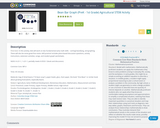
In this activity, kids will work on two fundamental early math skills – sorting/classifying, and graphing. There will also be some great fine motor skill practice! Includes place-based discussion questions, activity instructions, extension activities, songs, and student graph worksheets.NGSS: K-LS1-1, 1-LS1-1, partially meets K-ESS3-1 (book and discussion)Common Core: MP.4Time: 45 minutesMatierals: bag of dried beans ("16 bean soup"), paper bowls, glue, chart paper, the book "One Bean" or similar book about growing food plants, especially beans.

The true, inspiring story of Beauty, the bald eagle, who was shot, rescued, and received a 3D-printed prosthetic beak. The resource includes a lesson plan/book card, a design challenge, and copy of a design thinking journal that provide guidance on using the book to inspire students' curiosity for design thinking. Maker Challenges: (1) Use paper and pencil to design a prosthetic body part for a human or animal. Then use tinkercad.com to create a prototype. Finally, use a 3D printer to print the prosthetic. (2) Have students research animals who use prosthetics. Then, improve the design in Tinkercad and 3D Print.
A document is included in the resources folder that lists the complete standards-alignment for this book activity.

It’s easy to take today’s ubiquitous colored crayons for granted, but they were the result of one individual’s innovation. Biebow introduces Edwin Binney—a mustachioed man and head of a carbon black factory—who wished to make color-pigmented wax crayons that reflected the world outside. The resource includes a lesson plan/book card, a design challenge, and copy of a design thinking journal that provide guidance on using the book to inspire students' curiosity for design thinking. Maker Challenge: Think about the school/community/world in which you live and identify a problem that could be solved with a new invention.
A document is included in the resources folder that lists the complete standards-alignment for this book activity.
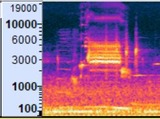
This series of activities explores animal behavior and how to research it. A scientist working in the Sound Ecology lab at Western Michigan University is featured. The introduction and first two activities are adaptable for all grade bands; the wrap-up section has 4 different options, depending on grade band.

This series of activities explores animal sounds and how to research them. A scientist working in the Sound Ecology lab at Western Michigan University is featured. The introduction and first two activities are adaptable for all grade bands; the wrap-up section has 4 different options, depending on grade band.

After the Great Depression struck, Ford especially wanted to support ailing farmers. For two years, Ford and his team researched ways to use farmers’ crops in his Ford Motor Company. They discovered that the soybean was the perfect answer. Soon, Ford’s cars contained many soybean plastic parts, and Ford incorporated soybeans into every part of his life. He ate soybeans, he wore clothes made of soybean fabric, and he wanted to drive soybeans, too. The resource includes a lesson plan/book card, a design challenge, and copy of a design thinking journal that provide guidance on using the book to inspire students' curiosity for design thinking. Maker Challenge: Think about the people in your community and the challenges they face. List three challenges that affect their daily life. Consider something you use every day and brainstorm how it could be repurposed or modified to address this problem.
A document is included in the resources folder that lists the complete standards-alignment for this book activity.

Meet savvy scientist and inventor Hedy Lamarr, also known for her career as a glamorous international movie star. Dubbed "The Most Beautiful Woman in the World," Hedy actually preferred spending time creating inventions in her workshop to strutting down the red carpet. Hedy co-invented the technology known as frequency hopping, which turned out to be one of the most important scientific breakthroughs of the twentieth century! Today's cell phone, computers, and other electronic devices would be more vulnerable to hacking without the groundbreaking system discovered by a world-famous actress and gifted inventor. The resource includes a lesson plan/book card, a design challenge, and copy of a design thinking journal that provide guidance on using the book to inspire students' curiosity for design thinking. Maker Challenge: Create small groups. Pass out one of the challenges listed in the lesson plan/book card to each group for them to come up with an invention that will solve the problem at hand.
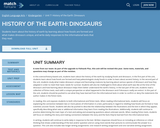
In this science/history-based unit, students learn about the history of the earth by studying fossils and dinosaurs. In the first part of the unit, students learn about how fossils are formed and how paleontologists study fossils in order to learn about ancient history. In the second part of the unit, students study what makes dinosaurs unique and fascinating creatures by learning about various species of dinosaurs and how they adapted in order to meet their basic needs for survival. Students will also be challenged to think about what earth was like at the time of the dinosaurs and how learning about dinosaurs helps them better understand the earth’s history. In the last part of the unit, students read a collection of fiction texts, each with a unique perspective on what happened to the dinosaurs and if dinosaurs really are extinct. In this part of the unit, students should be pushed to use what they have learned from the informational texts in order to confirm or deny the statements the author makes in the fiction texts.
In reading, this unit exposes students to both informational and fiction texts. When reading informational texts, students will focus on explaining the connection between two or more pieces of information in a text, particularly in regard to retelling how fossils are formed or how scientists uncover fossils. Students will also be pushed to describe the relationship between the illustrations and the text in which they appear, specifically describing what new or additional information they learn from reading the illustrations. Additionally, students will continue to practice determining the main topic of a text and asking and answering questions about unknown words. When reading fiction texts, students will focus on retelling the story and making connections between the story and the facts they’ve learned from the informational texts.
In writing, students will continue to write daily in response to the text. Written responses should focus on including an inference or critical thinking that shows understanding of the text and/or question and on using more words than pictures to communicate the answer to a question. This unit also includes two longer writing assignments: one research writing assignment and one narrative writing assignment.

Frances Gabe detested housework, so she invented a contraption to free herself from this tedious task forever: a self-cleaning house! Gabe's wacky, wonderful home included almost 70 new patented inventions, from a soap-spraying sprinkler in the ceiling to a kitchen cabinet that washed, dried, and stored dishes all in one place. Though Gabe's invention didn't catch on, her determination and clever thinking remind us that we don't have to accept the world as it is; we can improve it using our minds and our own two hands. The resource includes a lesson plan/book card, a design challenge, and copy of a design thinking journal that provide guidance on using the book to inspire students' curiosity for design thinking. Maker Challenge: Frances Gabe created over 70 inventions because she hated cleaning. What is one thing you hate doing for chores? Develop an invention to have it clean itself.
A document is included in the resources folder that lists the complete standards-alignment for this book activity.
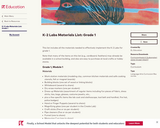
This list includes all the materials needed to effectively implement the K-2 Labs for grade 1. Note that many of the items on this list (e.g., cardboard, feathers) may already be available in a school building, and also are easy to purchase at local crafts or hobby stores.

Meg set out to climb up and investigate the rain forest tree canopies — and to be the first scientist to do so. But she encountered challenge after challenge. Male teachers would not let her into their classrooms, the high canopy was difficult to get to, and worst of all, people were logging and clearing the forests. Meg never gave up or gave in. She studied, invented, and persevered, not only creating a future for herself as a scientist, but making sure that the rainforests had a future as well. The resource includes a lesson plan/book card, a design challenge, and copy of a design thinking journal that provide guidance on using the book to inspire students' curiosity for design thinking. Maker Challenge: Your community has many different areas to explore - it might be a park, a grocery store, a forest, or an alley. For some people, it might be difficult to explore these areas because they may have differing abilities. Select one area in your community, and come up with a plan to build a way for it to be more accessible to everyone.
A document is included in the resources folder that lists the complete standards-alignment for this book activity.

The true story of how Momofuko Ando was inspired to create one of the world’s most popular foods after seeing long lines of hungry people waiting for a simple bowl of ramen following World War II. He dreamed about making a new kind of ramen noodle soup that was quick, convenient, and tasty for the hungry people because he believed that peace follows from a hungry stomach. With persistence, creativity, and a little inspiration, Ando succeeded. The resource includes a lesson plan/book card, a design challenge, and copy of a design thinking journal that provide guidance on using the book to inspire students' curiosity for design thinking. Maker Challenge: Develop a food product (a new food, tool, or invention, et al) to help increase access to food in your community.

A young girl has a wonderful idea to make the most MAGNIFICENT thing! But making her magnificent thing is anything but easy, and the girl repeatedly tries and fails. Eventually, she quits, but a walk with her dog and time to think, she comes back to her project with renewed enthusiasm and manages to get it just right. The resource includes a lesson plan/book card, a design challenge, and copy of a design thinking journal that provide guidance on using the book to inspire students' curiosity for design thinking. Maker Challenge: Create small groups. Pass out one of the challenges listed in the lesson plan/book card to each group for them to come up with an invention that will solve the problem at hand.
A document is included in the resources folder that lists the complete standards-alignment for this book activity.

Isatou Ceesay observed a growing problem in her community where people increasingly disposed of unwanted plastic bags, which accumulated into ugly heaps of trash. She found a way to be the agent of change by recycling the bags and transforming her community. The resource includes a lesson plan/book card, a design challenge, and copy of a design thinking journal that provide guidance on using the book to inspire students' curiosity for design thinking. Maker Challenge: Use plastic bags to develop a new product (i.e. jump rope).
A document is included in the resources folder that lists the complete standards-alignment for this book activity.
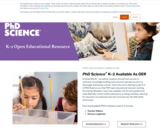
PhD Science Grade Levels K–2 is available as downloadable PDFs. The OER consists of Teacher Editions and student Science Logbooks for every module.
With PhD Science®, students explore science concepts through authentic phenomena and events—not fabricated versions—so students build concrete knowledge and solve real-world problems. Students drive the learning by asking questions, gathering evidence, developing models, and constructing explanations to demonstrate the new knowledge they’ve acquired. The coherent design of the curriculum across lessons, modules, and grade levels helps students use the concepts they’ve learned to build a deep understanding of science and set a firm foundation they’ll build on for years to come.
Cross-curricular connections are a core component within PhD Science. As an example, every module incorporates authentic texts and fine art to build knowledge and create additional accessible entry points to the topic of study.
Three-dimensional teaching and learning are at the heart of the curriculum. As students uncover Disciplinary Core Ideas by engaging in Science and Engineering Practices and applying the lens of Cross-Cutting Concepts, they move from reading about science to doing science.
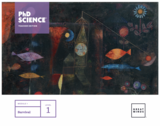
Throughout the module, students study the anchor phenomenon, life at a pond, and build an answer to the Essential Question: How do pond plants and pond animals survive in their environment? As students learn about each new concept, they revisit and refine a model that represents how plants and animals survive in a pond environment. At the end of the module, students use their knowledge of the ways plants and animals survive to explain the anchor phenomenon, and they apply these concepts to a new context in an End-of-Module Assessment. Through these experiences, students develop an enduring understanding that plants and animals have body parts that function in ways that help the plants and animals survive in their environment. Students also develop the understanding that plants and animals of the same kind are recognizable as similar but can vary in many ways and that many animal parents engage in behaviors that help young offspring survive.
With PhD Science®, students explore science concepts through authentic phenomena and events—not fabricated versions—so students build concrete knowledge and solve real-world problems. Students drive the learning by asking questions, gathering evidence, developing models, and constructing explanations to demonstrate the new knowledge they’ve acquired. The coherent design of the curriculum across lessons, modules, and grade levels helps students use the concepts they’ve learned to build a deep understanding of science and set a firm foundation they’ll build on for years to come.
Cross-curricular connections are a core component within PhD Science. As an example, every module incorporates authentic texts and fine art to build knowledge and create additional accessible entry points to the topic of study.
Three-dimensional teaching and learning are at the heart of the curriculum. As students uncover Disciplinary Core Ideas by engaging in Science and Engineering Practices and applying the lens of Cross-Cutting Concepts, they move from reading about science to doing science.
© 2020–2022 Great Minds PBC. Except where otherwise noted, this content is published under Great Minds OER License 1 (greatminds.org/gm_oer_1). Use limited to noncommercial educational purposes. COMMERCIAL REPRODUCTION PROHIBITED.
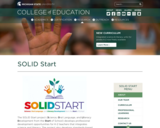
The SOLID Start project (Science, Oral Language, and Literacy Development from the Start of School) develops professional development opportunities for K-2 teachers that integrates science and literacy. The project also develops standards-based, integrated science and disciplinary language and literacy curriculum materials designed for K-2 children.
***MUST CREATE A FREE ACCOUNT TO USE MATERIALS.***